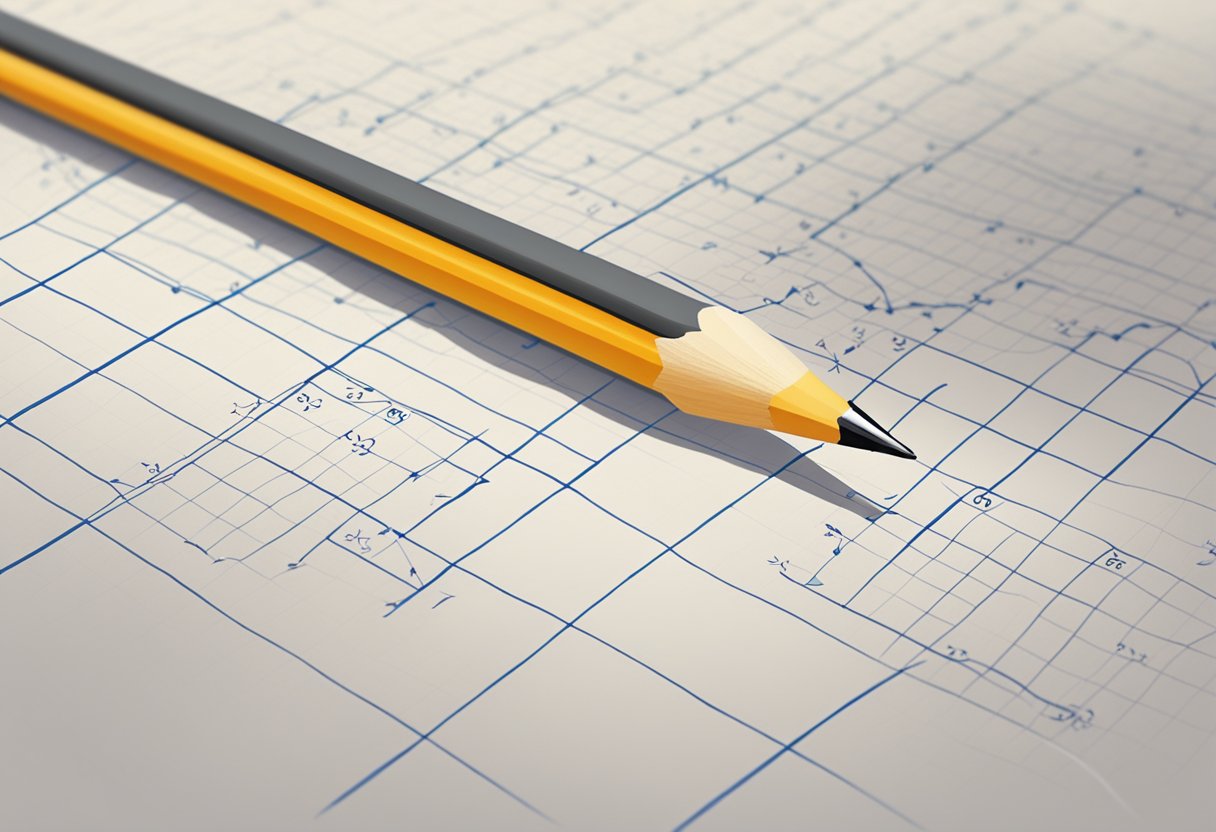JUMP TO TOPIC

To solve linear equations, I always begin by identifying the variable and the constants within the equation. A linear equation is a mathematical statement that shows the equality of two expressions, often involving a variable that could represent a number.
The solution to such an equation is the value of the variable that makes the equation true when substituted back into the original equation.
Solving linear equations is a foundational skill in algebra. In my experience, understanding the properties of equality and performing operations to isolate the variable are crucial.
This includes combining like terms and using inverse operations to effectively move constants and coefficients from one side of the equation to the other.
Knowing the various methods to uncover the solution to a linear equation can feel like unlocking a puzzle.
Whether it’s through graphing, substitution, elimination, or cross-multiplication, there’s a sense of accomplishment in finding the value of the variable and ensuring the integrity of the original equation. Stick around, and you’ll discover that the solution is often easier to find than you might think!
Steps for Solving Linear Equations
When I approach solving the linear equations, my goal is to find the value of the variable that makes the equation true.
t
A linear equation can be in one or more variables, but let’s focus on the common scenario involving a single variable. Here’s how I usually proceed:
Identify the type of linear equation: It could be in standard form e.g., ( ax + b = 0 ), which is a first-degree equation with coefficients ( a ) and ( b ), and a constant ( c ).
Simplify the equation: Combine like terms and simplify both sides of the equation if needed. This could involve removing parentheses or combining constants.
| Action | Example |
|---|---|
| Combine terms | ( 3x + 2 – 5x) becomes (-2x + 2) |
| Simplify | ( 2(x + 3) – 7 ) simplifies to ( 2x + 6 -7 ) |
Isolate the variable: Move all the terms with variables to one side and constants to the other. For example, ( 2x = 10 ) would become $ x = \frac{10}{2} $.
Solve the equation: Perform any necessary operations to solve for the variable.
In a multi-variable scenario, or when the equation is part of a system of equations, I use one of these methods:
Substitution Method: I solve one equation for one variable and then substitute that solution into another equation.
Elimination Method: I add or subtract equations to eliminate one variable and solve for the other.
Graphical Method: Equations are represented on a coordinate plane to find the solution at the point where the lines intersect.
Cross Multiplication Method: Used primarily for equations that form a proportion, where I cross multiply to find the values of the variables.
Remember that a linear equation graph is always a straight line, and the slope represents the rate of change of the variable. These methods provide a structured approach to finding a solution.
Advanced Solutions
When tackling advanced solutions of linear equations, I typically employ several strategies. First, when dealing with fractions, I find the least common denominator (LCD) to simplify the equation. Let’s say I have $\frac{1}{3}x + \frac{2}{5} = \frac{3}{4} $; finding the LCD helps me combine the fractions.
In systems involving three variables, I’ve found the substitution method helpful, where I solve one equation for a variable and substitute that expression into the others. Moreover, when equations get complex, simplifying equations and combining like terms become essential steps to finding a solution.
Consider this system:
$$ \begin{align*} x + 2y – z &= 5 \ 2x – 3y + 2z &= -1 \ -3x + y + z &= 3 \end{align*}$$
A matrix approach is efficient here, writing it as an augmented matrix and reducing it to row-echelon form to solve for the variables.
For equations containing square roots, ensure you square both sides to eliminate the square root. However, remember to check for extraneous solutions, as squaring can introduce solutions that don’t satisfy the original equation.
The graphical method is another powerful tool. Plotting each equation on a graph can visually represent solutions, especially when looking for intersections in a system of linear equations. It’s key to find at least two points to draw each line accurately.
Here’s a table for method suitability based on the type of linear equation:
| Equation Type | Suggested Method |
|---|---|
| Fractions | Find LCD and Simplify |
| Three Variables | Substitution or Matrix Method |
| Containing Square Roots | Square Both Sides |
Through these methods, I confidently approach even the most daunting linear equations.
Examples of Solving Linear Equations
When I encounter a linear equation in one variable, my goal is to isolate that variable on one side of the equation. For instance, consider the equation $2x + 3 = 7$. I would perform the following steps:
- Subtract 3 from both sides: $2x = 4$.
- Divide both sides by 2: $x = 2$.
This process yields the solution where $x = 2$.
Now, let’s tackle a linear equation with two variables using the substitution method:
- Solve one of the equations for one variable. If I have $y = 2x + 1$ and $x + y = 4$:
- Substitute $y$ in the second equation: $x + (2x + 1) = 4$.
- Simplify and solve for $x$: $3x + 1 = 4 \Rightarrow 3x = 3 \Rightarrow x = 1$.
- Use the value of $x$ to find $y$: $y = 2(1) + 1 = 3$.
So, the solution for the system is $x = 1$, $y = 3$.
A method for solving a system of linear equations is by elimination:
- Align two equations: $\begin{cases} 2y + 3x = 5 \ 4y – x = 11 \end{cases}$.
- Multiply as needed to cancel out one variable: $\begin{cases} 4y + 6x = 10 \ 4y – x = 11 \end{cases}$.
- Subtract one equation from the other: $(4y + 6x) – (4y – x) = 10 – 11$.
- Solve for $x$: $7x = -1 \Rightarrow x = -\frac{1}{7}$.
- Substitute $x$ to solve for $y$: $4y – (-\frac{1}{7}) = 11 \Rightarrow 4y = \frac{78}{7} \Rightarrow y = \frac{39}{14}$.
So, our solution here is $x = -\frac{1}{7}$, $y = \frac{39}{14}$. These examples show that solving linear equations involves systematic processes, whether they’re in one variable, two variables, or more complex systems of linear equations.
Conclusion
In this guide, I’ve shown you the techniques to tackle linear equations, highlighting methods that cater to various kinds of problems you may encounter.
Remember, linear equations typically take the form of $ax + by = c$, where $a$, $b$, and $c$ are constants. The solutions to these equations represent points that lie on a straight line when plotted on a Cartesian plane.
To ensure you’re on the right track, perform checks on your solutions. Substitute them back into the original equation to verify their accuracy.
For instance, if you determined the solution to the equation $2x + 3 = 7$ to be $x = 2$, plugging it back in will confirm that $2(2) + 3$ indeed equals $7$.
Practicing these methods will increase your confidence and ability to solve linear equations efficiently. There’s a variety of resources available, including step-by-step guides and interactive tools, that can offer further assistance.
As you progress, you may find that what once seemed daunting is now a set of problems you can solve with ease.
Always keep an eye out for special cases, such as equations with no solution or infinitely many solutions, which occur when dealing with parallel lines or the same line, respectively. These scenarios are as important to recognize as finding a unique solution.
I’m sure you will find that with a bit of practice, solving linear equations becomes a straightforward and rewarding process, enhancing your overall mathematical skillset.
